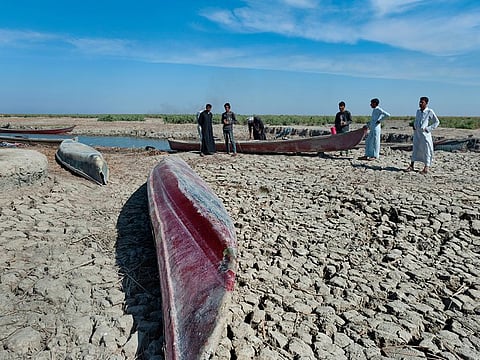Iraq’s water crisis deepens as climate change and geopolitics collide
Record-high temperatures, dwindling rivers, compound Iraq’s acute water crisis

Iraq, the cradle of civilisation, is facing an existential challenge: Drought and severe water shortage that threaten to turn the “land of the two rivers” into a parched desert.
Climate change and regional politics are turning this once fertile country, fed by two great rivers, into a desolate and arid land where the fate of over 43 million inhabitants hangs in the balance.
Time is not on Iraq’s side. Failing crops, drying rivers, poor rainfall rates, weather extremes, and political squabbling are playing havoc with the country.
Never before have the residents of Baghdad seen the water level in the Tigris and the Euphrates so depleted. People now cross the dry river bed of both rivers on foot. This is how catastrophic the current crisis has become.
Lakes turned into dust bowls
Climate change has contributed to this acute phenomenon. Iraqis have endured record-high temperatures this summer amid endemic electricity cuts and declining essential services. The famed marches in the south have dried up while most lakes and streams have been turned into dust bowls.
Farmers have seen their wheat, vegetable, and fruit harvests decline for the second year in a row because of severe drought conditions. Eighty-five per cent of agriculture in Iraq depends on water supplied by the Tigris and Euphrates.
It is no wonder that United Nations High Commissioner for Human Rights, Volker Türk, said earlier this month, that the intense summer heat and pollution in southern Iraq indicate that the “era of global boiling” has arrived. Iraq has become a case study of how climate change can actually kill nations.
An unimaginable catastrophe
Iraq’s two great rivers start their long journey from Turkey, passing through Syria before reaching Shatt al Arab in the Arabian Gulf.
The Tigris flows from the mountainous areas surrounding the Turkish Lake Hazar, with a length of 1750 kilometres, of which 1400 kilometres is in Iraqi territory, as it passes through northeastern Syria before entering Iraq at the town of Fish Khabur, then it links with the Euphrates River and empties into the Arabian Gulf.
The Euphrates is considered an auxiliary of the Tigris, originating from the Taurus Mountains in Turkey and is formed by two main tributaries, the Murad Su and Kara Su, before heading south towards Syria.
The total length of the Euphrates reaches about 3000 kilometres, of which 1160 kilometres lies in Iraqi territory, which it enters from the city of Al-Qaim in the west of the country after passing through several Syrian cities.
As the Tigris runs through Iraq it is fed by supplementary rivers that flow from Iran. According to studies, the water resources coming to Iraq from Iran amount to about 35 per cent of its annual rate of about 70 billion cubic meters.
Exacerbating water scarcity
In 2011, Tehran informed Baghdad of its intention to cut off all rivers heading to Iraq due to Iran’s water crisis. During the past two decades, Iran has cut off water from more than 45 tributaries and seasonal streams that fed the rivers and marshes in Iraq, the most important of which are the Karkheh, Karun, Tayyib, and Alwand rivers, and the Hoshiari River, which flows into Sulaymaniyah Governorate.
Turkey has constructed dams notably Ataturk Dam and the Ilisu Dam on the Tigris and Euphrates rivers. As a result, less water reaches Iraq, particularly during low-flow periods. Some water is diverted from Tigris and Euphrates rivers to meet Turkey’s own domestic and agricultural water needs.
Meanwhile, Iran has constructed several dams on rivers that flow into Iraq, including the Tigris and its tributaries. These dams have the ability to control the flow of water downstream. As a result, less water reaches Iraq, particularly during periods of low flow or drought.
Meanwhile, Iran has implemented various water diversion projects, such as the Gharraf River Diversion project, which directs water from the river to Iranian farmlands. This reduces the water inflow into Iraq, further exacerbating the water scarcity issue.
Failure to address such challenges has led to excessive pumping of groundwater for agricultural and industrial purposes causing aquifers to deplete rapidly, making it difficult for farmers and communities to access water. Inefficient irrigation practices and inadequate water management policies have exacerbated the problem.
While Turkey is sympathetic to Iraqi complaints and President Recep Tayyip Erdogan promised to allow more waters to flow through the two rivers, Iran is less cooperative.
“We decided to increase the amount of water flowing into the Tigris River for a month, as much as possible, to alleviate the plight of Iraq,” Erdogan said after a meeting in Ankara with Iraqi Prime Minister Muhammad Shia Al-Sudani.
In mid-August, Iran cut off, without warning, the waters of the Lower Zab River from Iraq, which is the third tributary of the Tigris River.
Unless Iraqis overcome their political differences, and allegiances, the country faces an unimaginable catastrophe. Climate change aside, their main objective must be to bring life back to the Euphrates and Tigris.
Osama Al Sharif is a journalist and political commentator based in Amman.
Sign up for the Daily Briefing
Get the latest news and updates straight to your inbox


